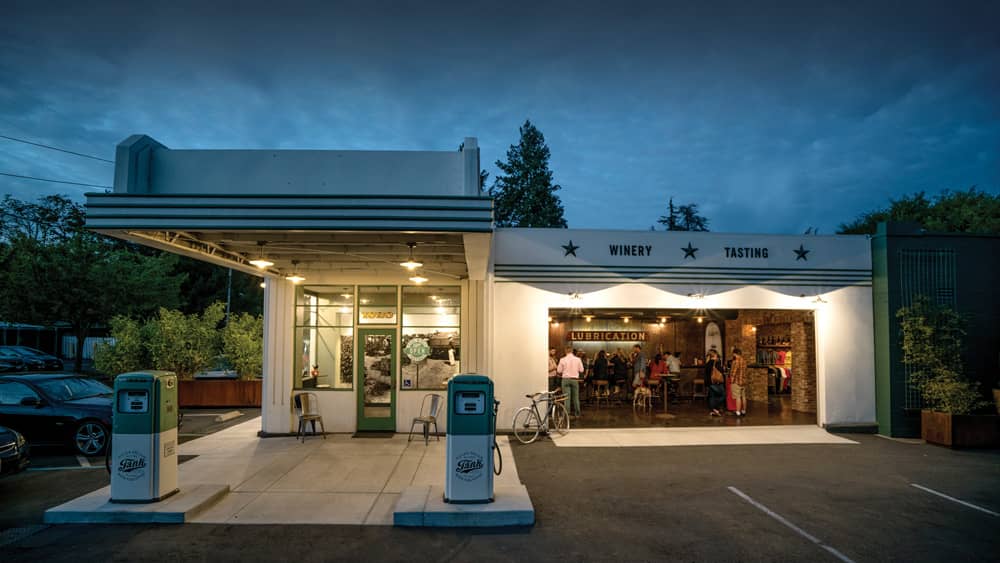
It’s. So. Not. Napa.
And that’s why it works.
Tank Garage Winery, with its eclectic tasting room in an old 1930s gas station/garage on Highway 29 in the heart of Calistoga, started as a dream. No business plan. No exit strategy.
“Just a mission to do cool shit,” says the story on its website.
And that’s just what it does.
Tank doesn’t hang its hat on fancy Cabernets or Chardonnays, like most Napa Valley wineries. It doesn’t own exclusive vineyards with fine pedigrees. No castles, no caves, no aerial trams. (Although those are all nice, too!) Its wines are made in an industrial facility, not a fancy chateau. And, in fact, most of the wines Tank makes—almost all of which are blends—generally have no Napa grapes in them at all.
And yet it has become one of Napa Valley’s most must-go-to destinations when visitors head to Napa, or when locals need a break from classic Napa tasting experiences.
“I was looking to do something creative,” says Tank’s founder, James Harder. And that he did.
Genesis
Harder and his wife, Colleen (or “Cole” for short), aren’t total renegades. They came to Napa the traditional way, purchasing 11 acres on the Silverado Trail in 2000—the year they married. James had many years of experience in wine marketing with Vincor; Cole was a direct marketing guru who co-owned a San Francisco agency that specialized in financial services marketing. Together, they built a winery and planted vineyards, opening James Cole Winery in 2007, a high-end producer of a variety of wines, but best known for its cult Cabernets. Later, Harder would develop a partnership with Jim Regusci and create T-Vine Winery, building a tasting room on Highway 29 at the southern end of Calistoga. T-Vine opened in 2013. Several months afterward, Harder found out that the old garage just up the street (once owned by the famous motorcycle racer Eddie Bratton) was up for sale. And that’s when Harder started dreaming.
Harder recalls that early in his wine marketing career he took an educational trip to Walla Walla, Wash. “And one of the wineries was in a service station. There was this little old guy making wine. And it was the thing I remembered most about that trip.” So, when the Calistoga garage, which had since been converted to house a wine shop and a pet grooming service, became available, Harder saw opportunity knocking and answered the door. He and Regusci acquired the service station and Tank Garage Winery was born. (Regusci and Harder have subsequently divided their partnership, with Harder taking Tank and Regusci retaining T-Vine.)

“As much as I love James Cole and consistently making the same wines, I wanted to explore and do different things,” he says. “As far as I was concerned, the handcuffs were off and we could do whatever we wanted.”
Harder enlisted many from his core team at James Cole: winemaker Bertus van Zyl, consulting winemaker Timothy Milos, and general manager Ed Feuchuk. He contracted with artists known for creative label design and then set about converting the garage into a tasting room, using his own personal affinity for vintage Americana, old cars and motorcycles, plus pinball machines. (He has a collection of several at home.)
“We pictured everything from the ’30s design—what Napa looked like coming out of Prohibition,” Harder says. They incorporated a Speakeasy (for wine club members’ exclusive use) into the floorplan and transformed the old service bay into the main tasting bar, complete with an antique LUBRICATION sign.
“Seems right,” says GM Feuchuk. “After all, you’re drinking wine and lubricating.”
As much as possible, they used authentic antiques and in-the-day vintage pieces for the tasting room décor. They restored the front Art Deco façade and put in a new roll-up door. Restored antique gas pumps were put out front and parking spaces were installed. They opened for business in 2014, but as they note in their website story, “Napa Valley just didn’t seem ready for an old garage pumping out eclectic wine blends and vintage vibes. The people who drove by looked confused and if they ever stopped, it was to try and get gas. Nobody seemed to get it at first.”
Today, the opposite is the case. Tank is booked out far in advance for its tastings (four current releases for $30, fee waived if you purchase three bottles of wine or you join MADE, Tank’s wine club). The popularity isn’t just because Tank is a fun and funky place, which it is. It’s because of the wines.
The wines
“We set out to make Tank wines something special,” Feuchuk relates. “We wanted to add to the conversation of wine in Napa Valley. Napa didn’t need another Cab producer, it needed someone who was going to do something different.”
Noting that the wine spectrum is wide, Feuchuk says Tank’s goal was and is to create unique wines for “unserved areas.”
Tank sources its grapes from all over Northern California and creates blends that are rather eye-popping for wine traditionalists. Pet-Nat sparkling wines, red-white blends, orange wines, natural wines, for example. All the wines are one and done—nothing is made twice or in subsequent vintages.
“The blend is a one-time use, the label is a one-time thing and the name is a one-time thing,” says Feuchuk. They are made in small batches that sell quickly—some as few as 25 cases, gone in an hour on an internet sale. “Once they are gone, they are gone forever,” he adds.
They borrowed the concept from the fashion industry. “There’s a segment called ‘streetwear.’ Basically, limited runs of high-end sneakers or clothing items like sweatshirts,” Feuchuk explains. The companies only offer a limited number, and that’s the draw. “People line up all around the block to get them.”
According to the most recent Streetwear Impact Report by HYPEBEAST and Strategy&, streetwear emerged as an antidote to wider fashion trends, stemming from countercultures like skate, surf and hip-hop. It also opened the floodgates to a demographic that was previously “not allowed” to show an interest in fashion: men.
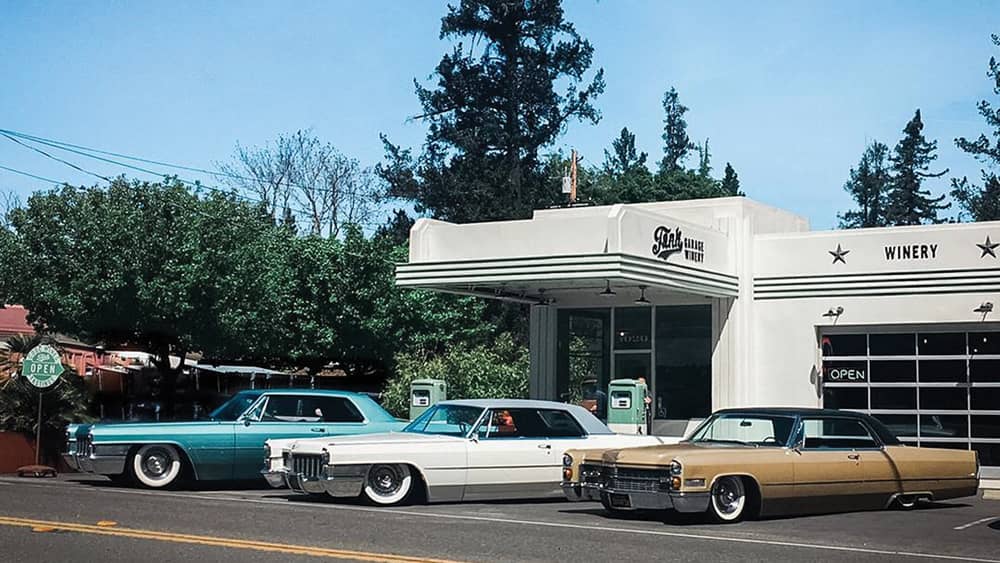
“We were inspired by that and wanted to bring it to wine—all limited edition, all one and done,” says Feuchuk. “Some of Tank’s wines are similar in style blends to those released the year before, with similar sourcing and style. And if you liked last year’s Rosé, you’re going to like this year’s, but our goal is to always be different and always be changing.”
Tank sells everything directly. The wine is not available in stores or restaurants. “We have no distribution at all,” Feuchuk says.
Their clientele is diverse. “Really people from all walks of life,” says Feuchuk. But Harder notes that the largest group of followers are “younger, emerging wine enthusiasts” who like Tank “because it doesn’t feel like mom and dad’s winery. We’re hipper.”
Harder says a lot of Gen Xers enjoy Tank for its nostalgia as well as for its wine. “We hear them say, ‘Grandpa had stuff like this,’ referring to tasting room signs that their grandparents had in their barns or garages,” says Harder. “But the commonality in all is people who are open to new and different experiences, who want to explore new varieties and blends, regardless of age or affinity to whatever.”
The labels
Part of the generational appeal of the wines is the names and labels. All creative, all artistic and some profane. “We’re kind of known not to be shy about using profanity,” laughs Feuchuk. Indeed, some of the winery’s best-selling swag carry a few choice words, including one that begins with “f.” In 2019, Tank released an Amador County blend of Barbera, Primitivo and Graciano called Middle Finger, complete with illustrations of such. The sales sheet’s first line was: “Finally, a wine that’s over the bullshit.”
“I’ve loved all the names and labels,” says Harder, “and I have great memories of all.” He and the team find inspiration in everything.
“I found a bunch of old matchbooks at a flea market,” he explains. “I pulled out one that said Juanita’s Beauty Salon.” An ah-ha moment. He had an artist sketch a label and Tank soon was offering an orange wine, a type of white wine made by leaving the grape skins and seeds in contact with the juice, creating a deep orange-hued finished product. The wine was then dubbed Juanita’s Beauty Salon.
Other memorable names include Golden Age of Roller Derby, a 2014 white wine tribute to Roller Derby’s Golden Age (1935-1950), “before the sport was overshadowed with theatrics,” says Feuchuk. Another is Like You Stole It, a red wine that featured a 1968 Dodge Charger on the label with instructions to “Push the pedal and drive like you stole it.” Then there was Skin Flick, a white wine “with lusty intentions” that had a recreated filmstrip from a porno film called “Wet Wash” as its label. The Tokyo Love Hotel is a Pet-Nat sparkling wine “with an hourly rate,” and the label was a photograph by a Japanese artist from Russia). And Boys Cry was a 2020 Carbonic white wine blend with a label illustration of a young man with a tear flowing out one eye. The latter implores people to “continue the dialogue about masculinity and emotion. Normalize boys hugging. Normalize boys needing each other. Normalize boys being feminine. Normalize strong friendships between boys. Normalize boys seeking help for mental health. Normalize platonic male affection. Normalize boys crying.”
Tank Cares
Today, Tank has a very large wine club in addition to its almost constantly booked tasting experiences. Though Harder is pleased with his unique garage tasting room and grateful for the loyal following his wines have amassed, he is even more proud of another Tank project—Tank Cares.
“These are the wines I remember most,” Harder says. “We pick out four to five wines a year where a good portion of our sales go to support charities. Our goal is to give at least $25,000 per year to various charities, which evolve and change based on needs and what’s going on at any given time.”
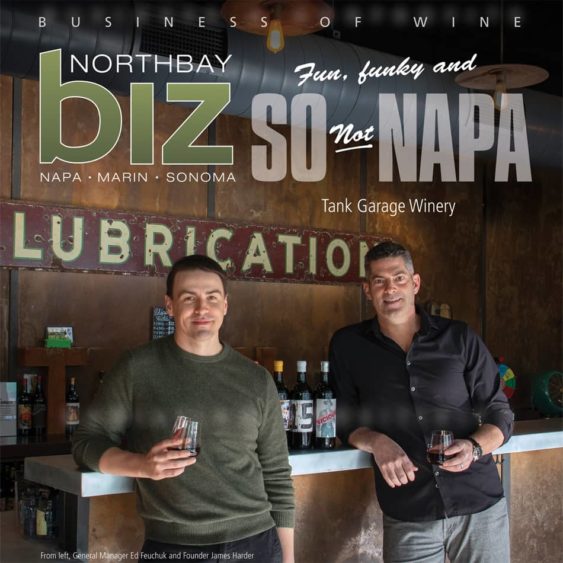
On the horizon
With his dream reaching fruition, Harder—a self-described overly creative soul—is setting his sights on the future. “We’re going to go down new paths and try new things,” he says. “We’re looking to open up a satellite tasting room in the Santa Barbara area because we think it’s a good fit. More than that, we’re going to continue to find good vineyards and become more involved in the sustainability and organic movements. First and foremost, we’re working with growers to have a fully organic 2024 vintage. We’re halfway there now. Obviously, this will require paying more for our grapes.”
When Harder and his team set out to create Tank Garage Winery, they settled on “Never Dream Alone,” as its ethos. The winery celebrates rebels, misfits, and daredevils (the Speakeasy even has an Evil Knievel pinball machine). There are portraits of bootleggers and a shrine to a colorful and bodacious motorcycle racer.

“A lot of the people on our team have blue hair, pink hair and tats [tattoos],” says Feuchuk. “It fits what we do. We celebrate differences. And it’s consistent from our winemaking through the people who work here. One thing I’m really proud of is that although some of our wines may seem super geeky or technical, our goal is always to make things that taste really good and have interesting stories. We just have a good recipe—good stories, good things to talk about, interesting concepts and then the wine is really delicious.”
After a moment, Harder adds, “We always say we are a ‘collection of misfits’ to describe not only our team but also, in a lot of cases, those that have an affinity for Tank and continue to inspire us—our customers. We knew from the start that our path was going to lead us against the grain and defy a lot of the traditional winemaking norms in our pursuit of doing something a little bit different with Tank. So ‘Never Dream Alone’ became a rallying cry to invite others to join us in our pursuit and dream of creating something different we can all enjoy together. We also hope it inspires others to do the same,” Harder says. “I cannot stress how grateful we are as a company, after what all the world has gone through the last couple of years, that our customers stuck with us.”
Onward…with a full “Tank.”
An Homage to Eddie Bratton
Inside Tank Garage Winery—under spotlights and on its own “alter”—is a 1947 Indian Chief motorcycle, a gleaming homage to one Eddie Bratton, a legendary motorcycle racer who once owned the 1930s gas station-garage and serviced motorcycles brought from far and wide. There are trophies Eddie won, as well as a life-sized wall photo of Eddie on a bike, racing in the Catalina Grand Prix.
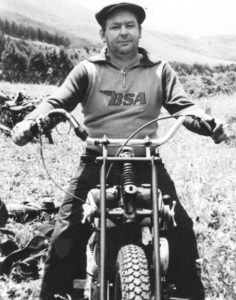
As the story is told, Bratton bought his first bike in 1926 in North Dakota when he was only 15 years old. He would later drive it all the way to California, surviving solely on onion sandwiches and potatoes he would dig up on farms along the route. When he arrived in San Francisco, he took a job at Hap Jones Indian Motorcycle dealership. There, he tuned bikes and manufactured custom “Bratton Cams” for racers looking for more power. We’re told that he only “wrenched and raced” Indian bikes because nothing else was good enough. After he stopped racing Indians, he moved on to Sprint Cars and Midget racers, racing at Calistoga Speedway according to Indian Motorcycle at War and Peace, a Facebook page dedicated to Indian motorcycles.
It’s not known exactly when Bratton bought the garage in Calistoga, but he reportedly retired in the 1980s and continued to live in a small place behind the garage, according to Fred Johansen. (A member of the Indian Motorcycle at War and Peace Group, Johansen met up with Bratton after he retired.) Johansen simply describes him as “A Legend.”

As for the 1947 Indian Chief, Ed Feuchuk, general manager of Tank Garage Winery says the team was alerted to the existence of it—in storage—and owned by a local Calistogan, right around the time they took over the garage. It took several months of pleading to get the owner to finally relent and sell the motorcycle, which they brought home to the garage.
“We think it is symbolic – sort of the soul of the place,” Feuchuk says. “We brought his legacy back here where it belongs and we are honoring it.”
Vintage Garagiste
Since its annual case production is too big to qualify, Tank Garage Winery is not officially a “garagiste.” But the fact that its tasting room is in an old garage—not to mention that many of its wines are produced in very small quantities—does conjure up such images.
Exactly what is a garagiste?
Garagistes originated in Bordeaux in the 1990s, when a group of winemakers started a movement against the barriers of entry to winemaking, according to the Wine Compass blog. Such barriers included the exclusivity of inheritance and extremely high expenses involved in owning property and vineyards. To combat this, the winemakers started making wines in their garages.
Today, the term garagiste refers to any winemaker making wine on a small scale and not in their own winery. They don’t own vineyards, bringing grapes in from elsewhere or renting a few rows of vines from which they harvest grapes. The wines are mostly made at custom crush facilities, with the winemakers looking after their own production of small case lots.
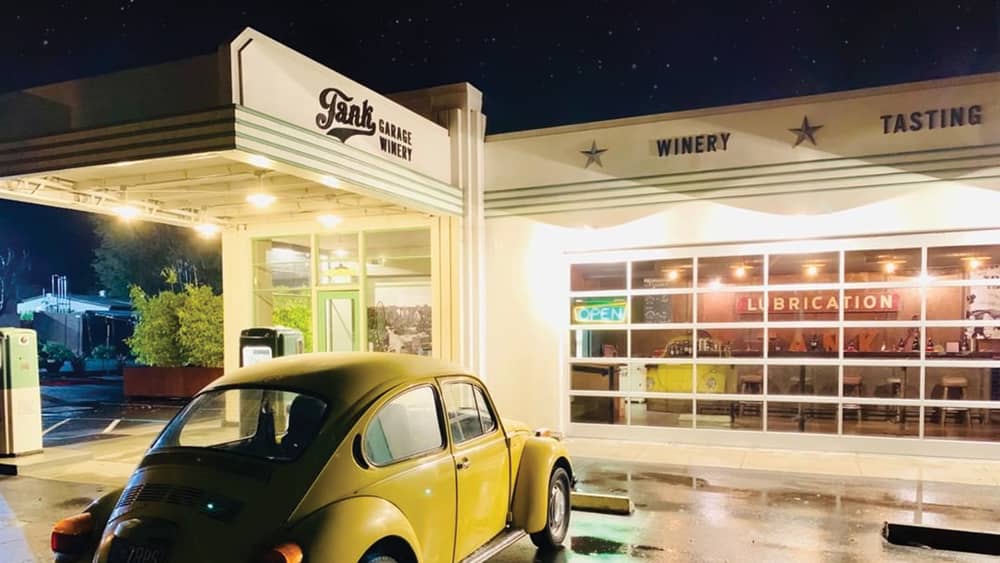
Garagistes are common, so much so that California has a Garagiste Festival, held for the 10th time last December in Paso Robles.
Less overhead is involved, so garagistes can get into the industry at a fairly low cost. Typically, garagistes are more experimental (as is Tank Garage Winery) and if something goes wrong, the investment is a lot less of a financial blow because production is so low.
Wine Compass notes that there are arguments for and against garagistes. “On the one hand, a new wave of winemakers has the opportunity to get involved in what is often considered an exclusive industry and we get to try some fantastic and interesting wines that otherwise probably wouldn’t exist; however, there is also the school of thought that this approach undermines the importance of terroir, history and the traditional education and role of a winemaker, and that practiced techniques of longstanding winemakers is not something we should disregard.”
winecompass.com
[Photos courtesy of Tank Garage Winery]



